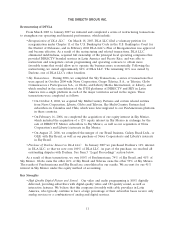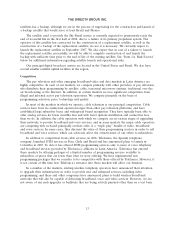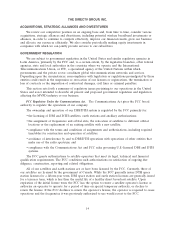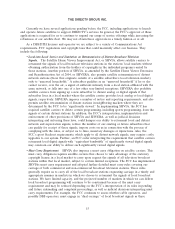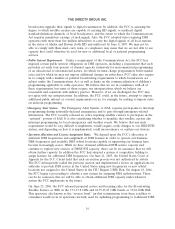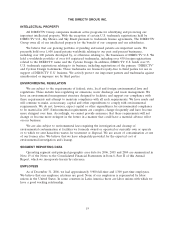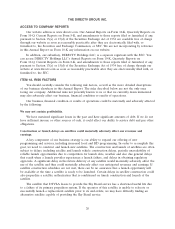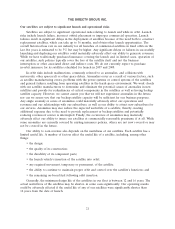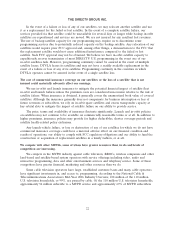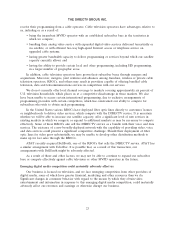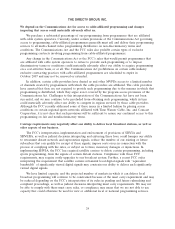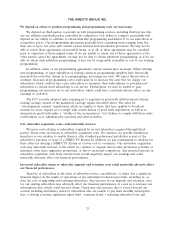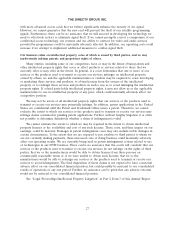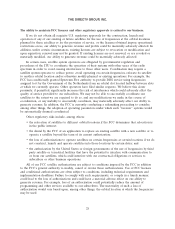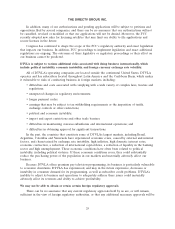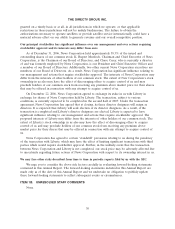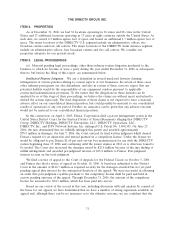DIRECTV 2006 Annual Report Download - page 32
Download and view the complete annual report
Please find page 32 of the 2006 DIRECTV annual report below. You can navigate through the pages in the report by either clicking on the pages listed below, or by using the keyword search tool below to find specific information within the annual report.THE DIRECTV GROUP, INC.
Our satellites are subject to significant launch and operational risks.
Satellites are subject to significant operational risks relating to launch and while in orbit. Launch
risks include launch failure, incorrect orbital placement or improper commercial operation. Launch
failures result in significant delays in the deployment of satellites because of the need both to construct
replacement satellites, which can take up to 36 months, and obtain other launch opportunities. The
overall historical loss rate in our industry for all launches of commercial satellites in fixed orbits in the
last five years is estimated to be 5% but may be higher. Any significant delays or failures in successfully
launching and deploying our satellites could materially adversely affect our ability to generate revenues.
While we have traditionally purchased insurance covering the launch and, in limited cases, operation of
our satellites, such policies typically cover the loss of the satellite itself and not the business
interruption or other associated direct and indirect costs. We do not currently expect to purchase
in-orbit insurance for its satellites scheduled for launch in 2007 and 2008.
In-orbit risks include malfunctions, commonly referred to as anomalies, and collisions with
meteoroids, other spacecraft or other space debris. Anomalies occur as a result of various factors, such
as satellite manufacturing errors, problems with the power systems or control systems of the satellites
and general failures resulting from operating satellites in the harsh space environment. We work closely
with our satellite manufacturers to determine and eliminate the potential causes of anomalies in new
satellites and provide for redundancies of critical components in the satellites as well as having backup
satellite capacity. However, we cannot assure you that we will not experience anomalies in the future,
nor can we assure you that our backup satellite capacity will be sufficient for our business purposes.
Any single anomaly or series of anomalies could materially adversely affect our operations and
revenues and our relationships with our subscribers, as well as our ability to attract new subscribers for
our services. Anomalies may also reduce the expected useful life of a satellite, thereby creating
additional expenses due to the need to provide replacement or backup satellites and potentially
reducing revenues if service is interrupted. Finally, the occurrence of anomalies may materially
adversely affect our ability to insure our satellites at commercially reasonable premiums, if at all. While
some anomalies are currently covered by existing insurance policies, others are not now covered or may
not be covered in the future.
Our ability to earn revenue also depends on the usefulness of our satellites. Each satellite has a
limited useful life. A number of factors affect the useful life of a satellite, including, among other
things:
• the design;
• the quality of its construction;
• the durability of its component parts;
• the launch vehicle’s insertion of the satellite into orbit;
• any required movement, temporary or permanent, of the satellite;
• the ability to continue to maintain proper orbit and control over the satellite’s functions; and
• the remaining on-board fuel following orbit insertion.
Generally, the minimum design life of the satellites in our fleet is between 12 and 16 years. The
actual useful lives of the satellites may be shorter, in some cases significantly. Our operating results
could be adversely affected if the useful life of any of our satellites were significantly shorter than
12 years from the date of launch.
21


